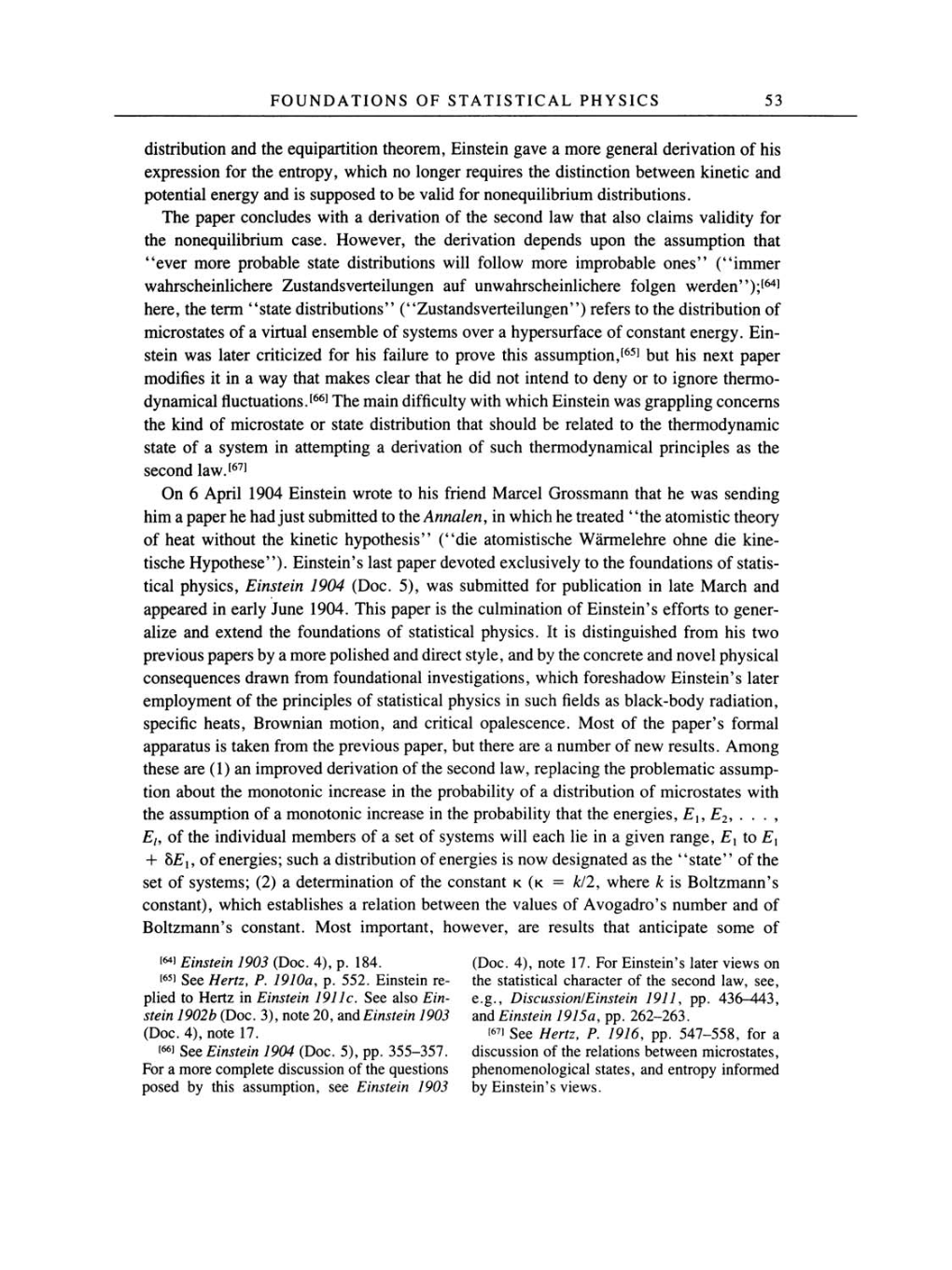FOUNDATIONS
OF STATISTICAL
PHYSICS
53
distribution and the
equipartition theorem,
Einstein
gave a more general
derivation of
his
expression
for
the
entropy,
which
no longer requires
the distinction between kinetic
and
potential energy
and
is
supposed
to be valid for
nonequilibrium
distributions.
The
paper
concludes with
a
derivation
of
the second law that also claims
validity
for
the
nonequilibrium case.
However,
the derivation
depends upon
the
assumption
that
"ever
more probable
state distributions will follow
more improbable
ones"
("immer
wahrscheinlichere
Zustandsverteilungen
auf
unwahrscheinlichere
folgen werden");[64]
here,
the term
"state distributions"
("Zustandsverteilungen")
refers to the distribution
of
microstates
of
a
virtual ensemble
of
systems over a hypersurface
of
constant
energy.
Ein-
stein
was
later criticized for his failure
to
prove
this
assumption,[65]
but his next
paper
modifies it in
a way
that makes
clear
that he did not intend to
deny or
to
ignore
thermo-
dynamical
fluctuations.[66] The main
difficulty
with which Einstein
was
grappling concerns
the kind
of
microstate
or
state distribution that should be related
to the
thermodynamic
state
of
a
system
in
attempting a
derivation
of
such
thermodynamical
principles as
the
second
law.[67]
On
6
April
1904 Einstein
wrote to his friend
Marcel Grossmann that he
was sending
him
a
paper
he had
just
submitted to the
Annalen, in
which he treated
"the
atomistic
theory
of
heat without the kinetic
hypothesis"
("die atomistische Wärmelehre ohne die kine-
tische
Hypothese").
Einstein's
last
paper
devoted
exclusively
to the foundations
of
statis-
tical
physics,
Einstein 1904
(Doc. 5),
was
submitted for
publication
in
late March and
appeared
in
early
June 1904. This
paper
is
the culmination
of Einstein's
efforts to
gener-
alize and extend the foundations
of
statistical
physics.
It
is
distinguished
from his two
previous
papers by a more polished
and direct
style,
and
by
the concrete and novel
physical
consequences
drawn from foundational
investigations,
which foreshadow
Einstein's
later
employment
of
the
principles
of
statistical
physics
in such fields
as black-body
radiation,
specific
heats,
Brownian
motion,
and critical
opalescence.
Most
of
the
paper's
formal
apparatus
is
taken from the
previous paper,
but there
are a
number
of
new
results.
Among
these
are
(1)
an improved
derivation
of
the second
law,
replacing
the
problematic assump-
tion about the
monotonic increase
in
the
probability
of
a
distribution of
microstates with
the
assumption
of
a
monotonic increase
in
the
probability
that the
energies,
E1,
E2,
. . . ,
El,
of
the individual members
of
a
set
of
systems
will each lie
in
a given
range,
E1,
to
E1,
+
8E1,
of
energies;
such
a
distribution
of
energies
is
now designated as
the
"state" of
the
set
of
systems;
(2)
a
determination
of
the constant
K
(K
=
k/2,
where
k is
Boltzmann's
constant),
which establishes
a
relation between the values
of
Avogadro's
number
and
of
Boltzmann's
constant. Most
important,
however,
are
results that
anticipate some
of
[64]
Einstein 1903 (Doc. 4), p. 184.
[65]
See Hertz, P. 1910a, p. 552. Einstein
re-
plied to Hertz in Einstein 1911c. See also
Ein-
stein 1902b (Doc. 3), note 20, and Einstein 1903
(Doc. 4), note
17.
[66]
See Einstein 1904 (Doc. 5), pp.
355-357.
For a more complete discussion
of
the questions
posed by this assumption, see Einstein 1903
(Doc. 4), note
17.
For
Einstein's
later views on
the statistical character of the second law, see,
e.g., Discussion/Einstein
1911, pp.
436-443,
and
Einstein
1915a, pp.
262-263.
[67]
See Hertz, P. 1916, pp.
547-558,
for
a
discussion
of
the relations between microstates,
phenomenological states, and entropy informed
by
Einstein's
views.
